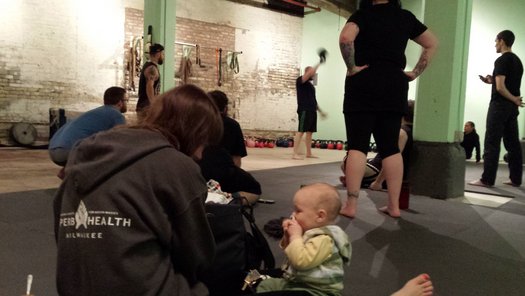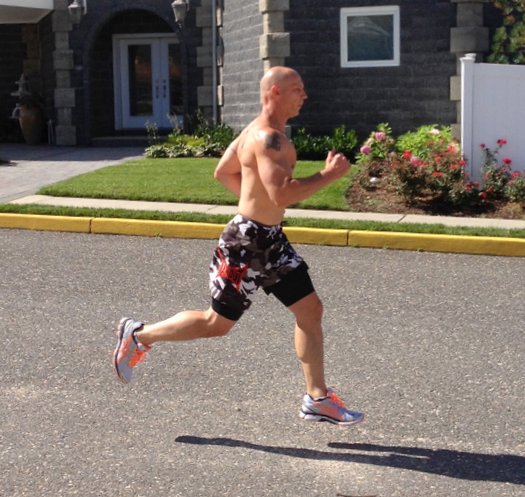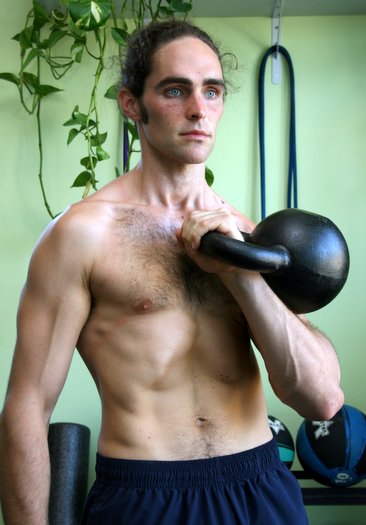
As athletes preparing for a grueling physical feat, we must ask ourselves, “How do I train properly?” There are many outstanding training programs already out there, so my hope for this program is to further help you and your students prepare for a successful RKC certification. I’ve personally had great success with this program, as have my clients. Please, feel free to ask questions about this program, as each individual’s needs differ. I’ll do my best to answer or point you in the direction of a fellow RKC Leader who can help.
A common concern in passing the RKC is the Snatch Test. 100 strict reps in 5 minutes or less proposes many issues beyond tearing hands. What many first time RKC hopefuls don’t account for is that the Snatch Test will occur after already having completed hundreds of swings, countless overhead presses and a plethora of skill refining corrective exercises. You’re already physically fatigued by the time the Snatch Test begins! Another major issue to consider: food and sleep! Your nervous system is taxed and therefore sleep is light (for most of us) and there is little time to eat throughout the day, especially to meet the needs of your great caloric output.
To ensure you’re getting adequate nutrition while training for the RKC keep it basic! Avoid large amounts of alcohol, sugar and refined oils. Stick with nutrient dense foods like sprouted grain cereal and bread, free-range eggs and organic meats, fruits and veggies. Looking for something to drink? Try water.
Hand care is of utmost importance, as is the correct kettlebell. Dragon Door’s kettlebells may cost more than the kettlebell you’ll find at your local used sports store but they’ll help prevent tears as they’re single mold cast iron. Huh? Single mold cast iron bells do not have a bump or ridge on the bottom of the handle. That ridge is best to avoid. It will cause extra friction during kettlebell ballistics. Here is a simple hand care protocol:
- Buy a 2-sided callus shaver. Sold at any drug store.
- Fill a bucket or pot with hot water.
- Soak hands and then shave skin.
- Apply Shea butter or Bag Balm (Yup, the stuff for cow udders. Hey! I’m from Vermont and now live in Wisconsin’s Dairyland! What can I say…)
2-3 times per week soak hands in water hot enough to make you think twice for about 5-10 minutes. Thoroughly dry hands with hand towel and wait about 30 seconds for moisture to completely evaporate. Now, take the callus shaver’s rough side and shave calluses for about 20-30 seconds on both hands. Flip callus shaver over to the gritty sand paper side and shave 20-30 seconds on both hands. The dead skin will start to crumble off, leaving your rough hands smooth. DO NOT over shave or your hands will burn.
Now we know how to eat and care for our hands, so how do we train? Good question. Below you’ll find a foolproof training program that’ll leave you with two thick pieces of paper and a shiny, new red shirt that says “RKC Instructor”.
*The following program is based on testing with a 24kg kettlebell. Please adjust based on your test size bell.
Monday – Light Day working on Level 1 skills. Smooth out your form and master the techniques.
Warm up: 12-16kg Arm Bar per side w/20-second hold; Turkish Get Up (TGU) per side; Pull up bar hang x10-seconds w/shoulders packed; hold deep Goblet Squat x10-seconds; x10 Swings; Cobra Stretch and x3-4 deep breaths arching on the inhale, Kime stance on the exhale.
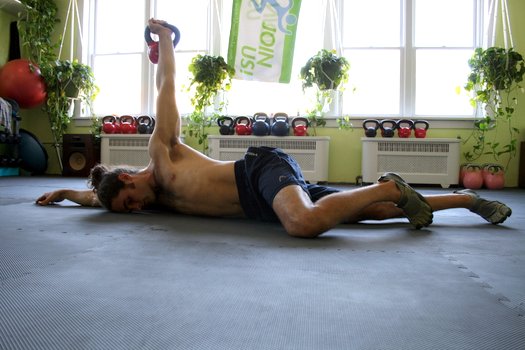
x10-minutes TGU with 16kg. Do as many TGUs as possible in 10 minutes with strict form.
*light weight is used to fix form. No record setting here…
x5 sets of x5 Cleans per side
x5 sets of x5 Presses per side
x5 sets of x5 Double Bell Front Squats
x5 sets of x10 Single Arm Swings per side
*all the above exercises are done with a 16KG Kettlebell. Switch in the air.
**allow 20-30 Seconds break in between the ballistics, x45 Sec – 1 minute in between the grinds.
Superset: x10-Second Hardstyle Plank with x5 Straight Leg Raises for a total of x5 sets. Ensure your lower back is hard pressed into the floor during the leg raise.
Tuesday – stretch, practice deep breathing to expand the diaphragm.
Wednesday – medium day
Warm up: same as above
x30 seconds – 1 minute Hardstyle Plank.
x10 2-handed Swings with anywhere from 24kg-32kg bell EMOTM (every minute on the minute) for 10 minutes.
*fast n’ loose between sets of Swings
x2 Single arm Clean, Squat and Press with 20-24kg EMOTM for 10 minutes
*alternate sides each minute
x1 TGU per side with 24-32kg (based on current level of strength) By using strict form you’ll know the appropriate weight to utilize.
x1-minute Hardstyle Plank.
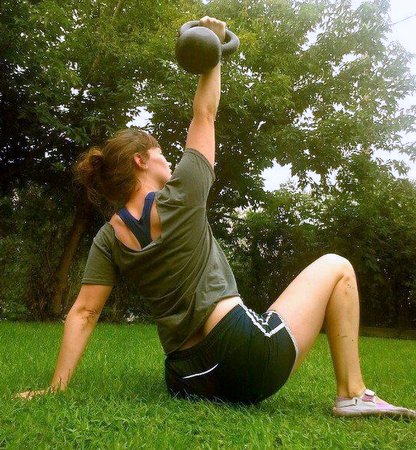
Thursday – same as Tuesday
Friday – Press/Pull Up Ladders
Clean and Press x1-5 reps superset with Pull Ups x1-5 reps
*if you perform x1 clean and press then perform x1 pull up. If you perform x2 clean and presses, perform x2 pull ups and so on; if you cannot yet do pull ups, supplement the number of pulls ups with seconds for a flexed arm hang. Ensure you end each rep with elbows locked out overhead before releasing the bar.
*climb the ladder up to 5 reps a total of twice per side. Example: x1 left, x2 right, x3 left, x4 right, x5 left and then start again with x1 right, x2 left, x3 right and so on…
*bell size is subjective to the individual’s current level of strength. Choose a bell you can perform x2 full ladders utilizing strict form. Practice this high load for about 6-weeks before moving up to a higher bell. Never sacrifice form for pride. If you need to do fewer reps, sets or weight so be it!
*When to move up? Once you can successfully complete x2 full ladders per side for a few consecutive weeks.
x5 set of x5 Heavy Bell Single Arm Swings per side with 32kg, for a total of 50 Single Arm Swings
Saturday and Sunday – Stretch, practice deep breathing, visualize passing the RKC, read Master The Kettlebell by Max Shank and watch Lord of The Rings (the extended versions!)
For the first 2-3 months, pick one Sunday per month grab a 24kg, set the timer for 5-minutes and:
Clean and Get-it-Overhead (without setting the bell down).
Options include: Clean and Press, Clean and Push Press or Clean and Jerk. Your resting positions are overhead or in the rack. This will help build your mental and physical threshold. Use a single kettlebell or if you’re mobility is like that of Bryan (below) use double bells!
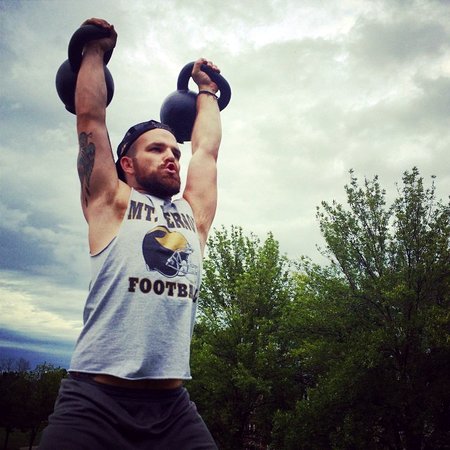
Before you begin incorporating Snatches, I recommend following the plan above for your first 2-3 months of RKC preparation. The purpose of this is to develop mobility, stability and comfort with the RKC standards. There is no use in weight training with improper form. I call this “injury training”. You want to “strength train”. Once the 2-3 month mark hits, practice this Snatch progression in place of the 5-minute Clean and Get-it-Overhead:
Weeks 1-6: 16kg or 20kg
Weeks 6+: 24kg
Week 1: Snatch for 1-minute
Week 2: Snatch for 1½-minutes
Week 3: Snatch for 2-minutes
Week 4: Snatch for 2½-minutes
Week 5: Snatch for 3-minutes
Week 6: Snatch for 5-minutes
Start over with a heavier bell if you achieve 100 strict Snatches in 5-minutes. Focus on form and the biomechanical breathing match.
There you have it! A simple, effective and nourishing kettlebell program. How cool would it be to see 90% + pass at the RKC Workshop in Milwaukee May of 2015?
A word to the wise: If you are not sure of the RKC standards, hire a local RKC to help you prepare. If there are no local RKCs, reach out to me or another member of the community and we’ll do our best to assist you via the Internet.
